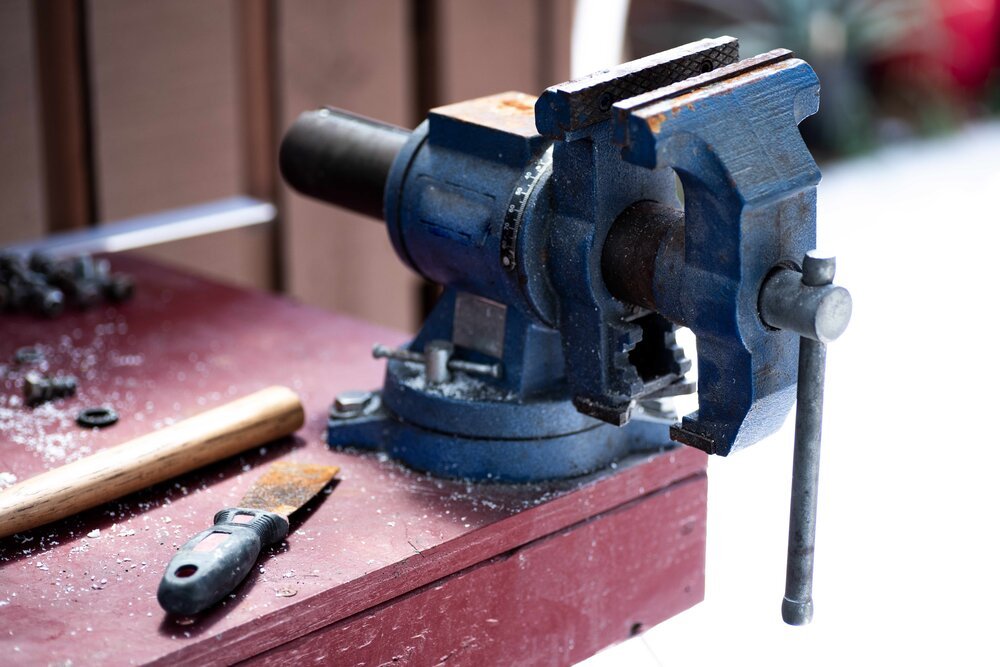Bench Vice Overview

Bench Vice consists of two jaws that are parallel and work together to clamp an object firmly and to hold it in a place.
One of these jaws is stationary and is attached to the fixed body section of the bench vice; on the other hand, another jaw is kept movable.
A threaded screw is connected to the jaws and runs through the body of the vice and their movement gets controlled by a handle which is placed on the outer point of the bench vice.
Then the pressure is exerted with the help of the handle through the screw and then it moves the sliding jaw.
Now when it is rotated in an anti-clockwise direction, the handle then moves the sliding jaw quite way from the stationary jaw, it then creates a gap between them. Now in the comparison, when it is rotated, the clockwise handle moves the jaw sliding close to the stationary one; therefore, closing them together.
The jaws hold the desired object in a firm way when brought together around a workpiece. Hand tools manufacturer in India provide all types of bench vice depending on all applications like drilling, gluing, filling, and sawing gets completed.
TIPS TO USE BENCH VICE CORRECTLY

While using a bench vice, there are some rules that must be followed:
• Ensure to clamp the workpiece securely and assure that full clamping surface of the jaws assist the object.
• Support the end of the object with any adjustable stand, box, or table to avoid any surplus strain on the bench vice while clamping a long workpiece.
• Avoid welding the base of a bench vice to any metal.
• Avoid using brazing or welding for repairing a bench vice. If you notice any damage or cracks in a benhc vice then avoid using that.
• To clamp heavy objectss, don’t use a light-duty vice.
• Make use of the bench vices that is designed specifically to hold the weight of object that you intend to work on.
• Try not to add an extension on the bench vice handle in order to increase the clamping pressure. This extra effort of the pressure of an extension may bend the handle and can break the vice.
Avoid hammering parts of a workbench vice, since this may damage it. The exception is if a vice is having fitted anvil, then you may do hammering on this part.
MATERIAL THAT YOU MUST CHOOSE
The choice of vice depends upon the type of work that is required to be done. A cast iron bench vice is the best suitable for completing the tasks like cutting or filing, hammering, where vibrations could occur.
If you require holding a wide workpiece, like brick or metal block that will stretch the vice to its limit, then the steel vice is best suitable as its high tensile strength corresponds to eliminated risks of breakage.
APPLICATIONS OF BENCH VICE
Bench Vises can be used to perform multiple tasks. To exemplify,
• METALWORKING
While working with a metal, vice is a useful apparatus, since it can hold the metal in place when filling, cutting or modifying its size and shape.
• WOODWORKING
Just like metalworking, a bench vice is a useful tool in performing woodworking actions. carpentry vice hold the wood in a sturdy manner while the work is getting done.
• GLUING
While working glue, a vice can provide many advantages. They can be secured into the jaws of the vice and afterward left to dry safely. In this way, the user time is saved and can perform other tasks while the glue sets.
• SAWING
While using a saw for cutting wood purposes, vices are very beneficial and are the most reliable way to hold wood still. Using a vice when sawing is safer and it prevents the risk of injury to the hands of user while cutting.
• DRILLING
The task of drilling need stability and precision. Making use of vice is crucial to perform certain tasks since it allows the user to drill holes with much accuracy by holding the object
• FILING OR SANDPAPERING
When any object require sandpapering or filing down, a vice may assist to make the task quite easier and efficient. Having the object secured in the vice, time gets saved rather than user having to move the object to find a convenient position.
While choosing a vice, you must consider many aspects to prove your choice a fruitful one.









